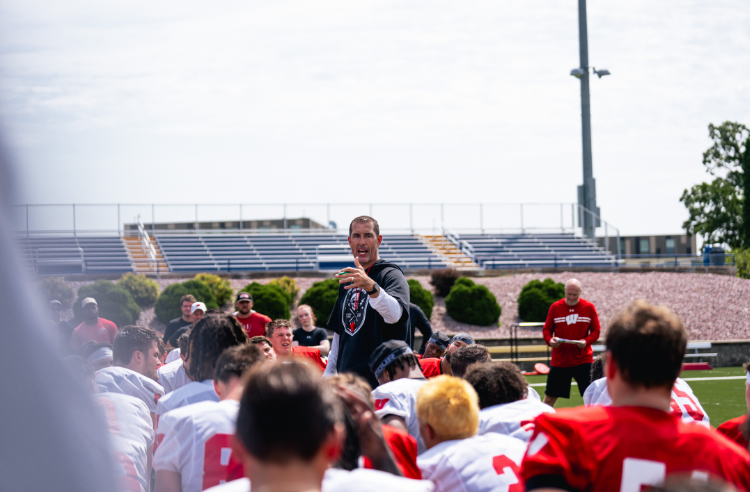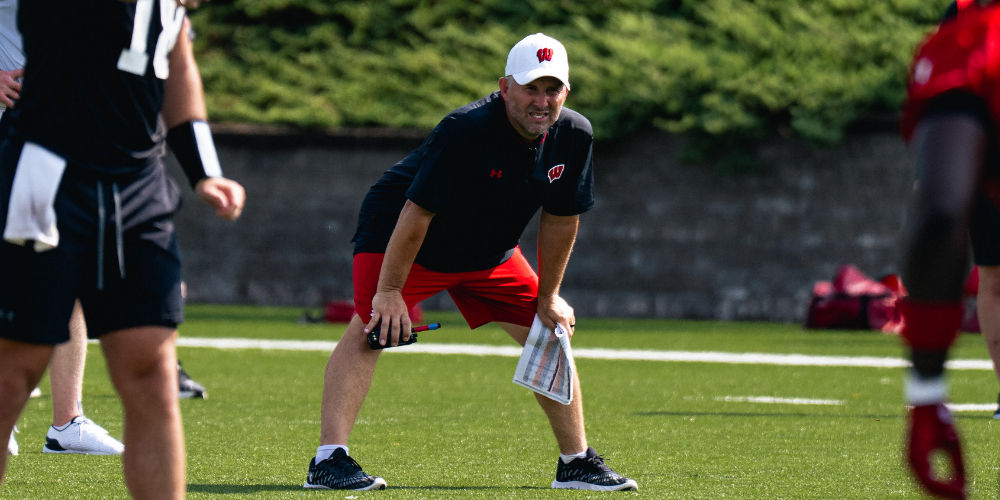Editor’s note: In conjunction with Wisconsin’s football season opener, all new content this week is free to view at Badger Connect. Please consider becoming a member for every article and weekly giveaways.
MADISON, Wis. — Mike Tressel was two sentences into his first interview session with reporters as Wisconsin’s defensive coordinator in January 2023, when he uttered an aspirational phrase for how he hoped the Badgers would perform: “Mesh the elite.” The idea, Tressel explained then, was to take the tools that helped Tressel’s pass defense excel at Cincinnati and meld them with Wisconsin’s traditionally stout run defense under former defensive coordinator Jim Leonhard.
If all went according to plan, Wisconsin would pick up where it left off as one of the premier defenses in the country. Over the previous decade, the Badgers’ average national rank for total defense was 7.2, with the unit ranking in the top seven in eight of those 10 seasons.
But what happened during Tressel’s first two seasons at Wisconsin were far from elite, the result of both schematic and personnel factors that limited the Badgers from reaching greater heights. Wisconsin finished Year 1 under Tressel ranked 39th nationally in total defense and closed Year 2 ranked 41st in that category. The Badgers, who just three years earlier were No. 1 in the country in total defense, run defense and yards allowed per play, ranked 91st last season in run defense and 60th in yards allowed per play.
Wisconsin opens its season Thursday night against Miami (Ohio) at Camp Randall Stadium in what will be the start of a critical Year 3 for Tressel and the defense. The hope is that the lessons learned from the past two seasons, which led to a revamped front this offseason, will yield the kind of results that have been so far lacking.
“I’m not one that’s going to sit here and overpromise,” Wisconsin coach Luke Fickell said. “I think we’ve hopefully realized that over the last couple years. But I do feel like we are in a better place, and I mean that even structurally. Everybody wants to say and is going to say they want their guys to be aggressive, and I think that has a lot to do with it. But it’s also about the things that you do on a consistent basis and the expectations that you have for guys.”
What, specifically, is different? Start with the defensive line. Fickell repeatedly said during the offseason that Wisconsin wore down up front during a five-game losing streak to close last season, in large part because the unit wasn’t physically ready to handle the rigors of the Big Ten. No game exemplified the need for change more than Wisconsin’s 42-10 loss at Iowa last November, in which the Hawkeyes ran for 329 yards with five touchdowns and averaged 6.1 yards per carry.
Last season, Wisconsin’s top six defensive linemen averaged 295 pounds. Four of the six players weighed less than 300 pounds. Wisconsin’s season-opening depth chart lists six players along the interior defensive line, which speaks to the level of competition this preseason. Those six players average 316 pounds. Three are returning players Ben Barten, Brandon Lane and Dillan Johnson. Three are transfers with Parker Petersen (Tulane), Jay’viar Suggs (LSU) and Charles Perkins (UT-Martin).
Wisconsin also created a greater variety of body types at outside linebacker by adding transfers Corey Walker (Western Michigan), Micheal Garner (Grambling State), Mason Reiger (Louisville) and Tyreese Fearbry (Kentucky). Walker and Garner, as well as returning outside linebacker Darryl Peterson, can line up off the edge or with their hand on the ground. Reiger and Fearbry are among a group of athletic edge defenders, along with Sebastian Cheeks and Nicolas Clayton, who have the potential to generate better pressure on pass-rushing downs. Sixth-year senior Aaron Witt is taking on a new role off the ball as the team’s “star” linebacker in specific packages.
Tressel said he emphasized three areas this offseason with the defense: more takeaways and tackles for loss and fewer explosive plays. Wisconsin ranked last in the country (134th) with 42 tackles for loss. The Badgers ranked tied for 110th in takeaways with 12 and tied for 125th in interceptions with four. And while Wisconsin ranked tied for 15th in surrendering plays of at least 20 yards, the staff demanded better.
Players said Fickell hammered home the importance of the small details by offering a series of presentations during the offseason and fall camp that highlighted advanced statistics. Wisconsin safety Austin Brown said one such statistic focused on what happens when a defense allows two or more explosive plays in a game.

Wisconsin coach Luke Fickell has addressed the team about improving several key statistical areas. (Photo courtesy of Wisconsin Athletics)
During FBS vs. FBS games over the previous five seasons, teams had a .474 winning percentage when they allowed multiple 20-yard plays, according to TruMedia. Teams held an .838 winning percentage in games in which they allowed one or fewer such plays. Offenses scored touchdowns on 60 percent of drives in which they produced at least one 20-yard play but just 11 percent of drives when they failed to produce a 20-yard play.
“There’s little things you don’t really think about as a real big thing that actually really matter,” Badgers safety Preston Zachman said. “When you do give up an explosive during practice or something like that, you can just tell how much it means. Everyone is pissed off. It’s like, ‘All right, we can’t have that.’ I think when it really becomes important to you as a player, as a whole defense, that’s when you can really see our defense grow and become successful.”
Players said Fickell noted Wisconsin’s defensive touchdown percentage in the red zone, which ranked tied for 78th nationally at 62.5 percent (32 of 51). Darryl Peterson said Fickell showed the team a full sequence from a game last season that included special teams, a defensive drive and an offensive drive that resulted in a Badgers touchdown.
The point was to emphasize the value of complementary football, which has been a much-discussed topic this offseason. Outside linebackers coach Matt Mitchell suggested that complementary football extended to practice, where the defense is seeing a new offense under coordinator Jeff Grimes that presents more of the types of physical challenges Wisconsin will face in the Big Ten this season.
Yet for all the statistics, perhaps the element that is most difficult to measure is a mentality shift. Tressel said in July before preseason practices began that Wisconsin’s defense struggled because of a lack of belief during difficult times. He noted he felt the defense was “hanging on for dear life” and simply trying to survive the down by holding onto a gap.
“I would say last year we had a lot of guys who prioritized themselves,” Barten said. “They wanted to be a huge one of the 11th instead of just knowing they’re one of the 11 who can create a functional, sound defense that is gap sound and aggressive.
“If you start becoming too much in the idea of, ‘I am this big part of my defense where I am the man,’ when you start becoming that attitude, damn, those gashes get big. You take too aggressive of a step to try and get to the ball and all of a sudden, you’re watching the running back cut back behind you. Your discipline is what makes plays. It’s not your ability.”
Tressel said the attitude and mentality change with this defense was contagious. He noted coaches established a new objective in which they tally what is called a “culture count.” Players earn points for celebrating with teammates after positive plays. Tressel said he believed it would have an impact not only on the defense but also the offense to see all 11 players coming together as a group. Those differences are part of why Wisconsin cornerback Ricardo Hallman noted: “This is the best unit I’ve seen as far as the intentionality and everybody having the same mindset.”
“When we do give up a play, they know that the objective wasn’t no eight-yard plays,” Tressel said. “Like, they don’t care and they move on much faster and refocus on, ‘Hey, one TFL here and we’re right back in charge of this series.’ I’m seeing the belief that even if we give up something, as long as it’s not an explosive, as long as we just stay on track with our objectives, we’ll be back in charge of the series.”
That it has taken two seasons for Wisconsin to reach this point is undoubtedly a source of frustration among fans. If the Badgers can’t successfully translate offseason gains into the season, a long road awaits given the team’s difficult schedule. If those changes do materialize, it could be the start of putting Wisconsin’s defense back on the right path.
“I think for anything over the last 30-some practices, there’s been a confidence built in allowing those guys to be more aggressive,” Fickell said. “But now they’ve got to go out and do it.”
(Top photo of Mike Tressel courtesy of Wisconsin Athletics)

